Chapter 1 Abstract Integration
1, Does there exist an infinite σ−algebra which has only countably many members?
Solution: No. There exists no such a infinite σ−algebra M which has only countably members.
Proof: Suppose M is a σ−algebra of subsets in a set X which has only infinite countably many
members. So we can pick from M a countably many members A1, A2,···. Without loss of generality,
{Ai}∞
i=1 are mutually pairwise disjoint, for otherwise letting
¯A1 = A1, ¯A2 = A2 − A1, · · ·, ¯Ak = Ak − k−1
Ai, · · ·
i=1
¯Aj = ∅ if i = j.
then clearly ¯Ai ∈ M and ¯Ai
Let 2N be the collection of all subsets of the natural numbers N, then it is well known that
the cardinal number of 2N is 2N = [0, 1] = C. (See p25, exercise 3 in the book of Jiang zejian).
For any given Y ∈ 2N , since Y is a countable set and M is a σ−algebra,
f : 2N → M is given by f(Y ) =
Y, Z ∈ 2N , Y = Z, then f(Y ) = f(Z).
n∈Y An. Then f is well defined and it is one to one, i.e.
n∈Y An ∈ M. Let
if
In fact, Y = Z implies that there exists an n0 ∈ Y
f(Z) = An0
Aj = ∅ if i = j
and n0 ∈ Zc, by the definition of f, An0
n∈Z An) = ∅. So, An0 ∈ f(Z)c
while An0 ∈ f(Y ), i.e. f(Y ) = f(Z). Therefore f : 2N → M is one-to-one, which implies that
C = 2N ≤ M ≤ N = C0 is a contradiction. So, the contradiction shows that M can not has only
countable many members.
Zc ⊂ N. Since Ai
(
We give the proof that 2N = [0, 1] = C here. For any given A ⊂ N, set ϕA(n) = { 1,
0,
if n ∈ A;
if n ∈ A.
Let g : A → (0, 1) is given by g(A) = 0. ϕA(1)ϕA(2) · ··, it is obvious that g is one-to-one. So,
2N ≤ [0, 1].
On the other hand, for any x ∈ (0, 1), set Ax = {r; r ≤ x, r ∈ R}, where R is the set of all
the rational in (0, 1). If x, y ∈ (0, 1) and x = y, by Berstein’s theorem, the density of rational in
R, Ax = Ay. So, (0, 1) ≤ R = 2N .
So, 2N = [0, 1] = C.
2
2, Prove an analogue of Theorem 1.8 for n functions.
Solution: We have the following result.
Theorem 1.8: Let u1, u2, ..., un be real measurable functions on a measurable space X, let Φ be
a continuous mapping of RN onto a topological space Y , and define
h(x) = Φ(u1(x), ..., un(x))
for x ∈ X. Then h : X → Y is measurable.
Proof: Since h = Φ ◦ f, where f(x) = (u1(x),
shows that it is enough to prove the measurability of f.
..., un(x)) and f maps X into Rn. Theorem 1.7
1
�
If R is any open rectangle in Rn with sides parallel to the coordinate super plane, then
R = I1 × I2 × · · · × In, where Ii = (ai, bi) ⊂ R1 (i = 1, 2, ..., n) are open segments and
f−1(R) = u−1
i (Ii) for i = 1, 2, ..., n, that is x ∈n
u−1
2 (I2)
1 (I1)
· · ·
u−1
n (In).
x ∈n
ui(x) ∈ Ii, then x ∈ u−1
In fact, for any given x ∈ f−1(R), we have f(x) = (u1(x), ..., un(x)) ∈ R = I1×I2×···×In and
i (Ii). On the other hand, for any
i (i), ui(x) ∈ Ii and f(x) = (u1(x), ..., un(x)) ∈ I1 × I2 ×···× In.
i (Ii), we have xi ∈ u−1
So f−1(R) is measurable for each open rectangle interval R ⊂ Rn as ui are measurable on X.
i=1 u−1
i=1 u−1
By Lindelif’s Theorem, every open set V is a countable union of open interval with sides
i=1 f−1(Ri) is measurable as well.
parallel to the coordinate super-plane, V =
Ri, So f−1(V ) =
n
2
3, Prove that if f is a real function on a measurable space X such that {x; f(x) > r} is measurable
for every rational r, then f if measurable.
Proof: For any α ∈ R1, there is a sequence of rational {rn; n = 1, 2, ...} such that r1 > r2 > r3 >
... > rn > ... > α with lim
n→∞ rn = α. So
{x; f(x) > α} =
{x; f(x) ≥ rn}.
+∞
n=1
(b) lim sup
n→∞
(an + bn) = inf
k≥1
= − sup
k≥1
sup{−ak,−ak+1, ...} = inf
k≥1
inf{ak, ak+1, ...} = lim inf
n→∞ an.
[sup{ak + bk, ak+1 + bk+1, ...}]
[sup{ak + bk, ak+1 + bk+1, ...}]
= lim inf
k≥1
{an} + sup
{bn}]
≤ lim inf
k→∞ [sup
n≥k
n≥k
n→∞ [sup{bn}]
n→∞ [sup{an}] + lim inf
n→∞ an + lim sup
n→∞ bn.
= lim inf
= lim sup
2
In fact, for any x ∈ {x; f(x) > α}, there is a n0 such that α < rn0 ≤ f(x), therefore
x ∈ {x; f(x) > α}. On the other hand, rn > α implies that
+∞
n=1
{x; f(x) ≥ rn} ⊂ {x; f(x) > α}.
By the condition, for any given n, {x; f(x) ≥ rn} is measurable, we see that {x; f(x) > α} is
measurable for any α ∈ R1. By Theorem 1.12, f is measurable.
4, Let {an} and {bn} be sequence in [−∞, +∞], prove the following assertions:
(−an) = − lim inf
(a) lim sup
n→∞ an;
n→∞
(an + bn) ≤ lim sup
(b) lim sup
n→∞ an + lim sup
n→∞
(c) If an ≤ bn for all n, then
n→∞ bn provided none of the sums is of the form ∞ − ∞;
n→∞ an ≤ lim inf
lim inf
n→∞ bn
show by an example that strict inequality can hold in (b).
Proof:
(a) lim sup
n→∞
{− inf{−ak,−ak+1, ...}}
(−an) = inf
k≥1
2
�
{an} ≤ inf
{ak} = lim inf
inf
n≥k
0, lim sup
(c) lim inf
n→∞ an.
k→∞ inf
n≥k
(an + bn) = 0 < 2 = 1 + 1 = lim sup
n→∞ bn = 1, but lim sup
n→∞
n→∞ an = lim
k→inf ty
In (b), the strict inequality can hold. For example, let an = (−1)n, bn = −(−1)n, then an+bn =
n→∞ an = 1, lim sup
n→∞ bn.2
5, (a) Suppose f : X → [−∞,∞] and g : X → [−∞,∞] are measurable. Prove that the sets
{x; f(x) < g(x)}, {x; f(x) = g(x)} are measurable.
(b) Prove that the set of points at which a sequence of measurable real-valued functions converges(to
a finite limit) is measurable.
Proof: (a1) Suppose f, g are measurable on X, then {x; f(x) < g(x)} is measurable. Suppose
{rn} is the set of rational in R1, we claim that
n→∞ an + lim sup
∞
{x; f(x) < g(x)} =
[{x; f(x) < rn}
{x; rn < g(x)}]
In fact,
n=1
x0 ∈ {x; f(x) < g(x)} ⇐⇒ f(x0) < g(x0)
⇐⇒ x0 ∈∞
⇐⇒ ∃rn0, such that f(x0) < rn0 < g(x0)
n=1[{x; f(x) < rn}{x; rn < g(x)}].
X. So, by the claim we have proved above, {x; f(x) < g(x)} is measurable.
For any r ∈ R, {x; f(x) < r} and {x; r < g(x)} are measurable since f, g are measurable on
(a2) By (a1), {x; f(x) = g(x)} = X − [{x; f(x) < g(x)}{x; f(x) > g(x)}] is measurable.
(b) Suppose {fn} is a sequence of real-valued measurable functions on (X,)(a measurable
space), then by Theorem 1.9(c), for any n, m ∈ N, |fn(x) − fm(x)| is a measurable function as | · |
is a continuous function on R1 × R1. So, {x;
|fn(x) − fm(x)| < a} is a measurable set for any
a ∈ R1.
Clearly, the set where {fn(x)} has finite limit is given by
+∞
+∞
A =
k=1
N =1
n,m≥N
{x; |fn(x) − fm(x)| <
}
1
k
by Cauchy’s criterion for convergence.
A is a measurable set because for any n, m ∈ N and k ∈ N, {x; |fn(x) − fm(x)| < 1
and M is a σ−algebra.
k} ∈ M
2
6, Let X be an uncountable set, let M be the collection of all sets E ⊂ X such that either E or
Ec is at most countable, and define µ(E) = 0 in the first case, µ(E) = 1 in the second. Prove that
M is a σ−algebra in X and that µ is a measure on M. Describe the corresponding measurable
functions and their integrals.
Proof: 1.) Since X c = ∅ is at most countable, we see that X ∈ M.
If A ∈ M, then either A or Ac is at most countable, i.e. either Ac or (Ac)c = A is at most countable,
so Ac ∈ M as well.
If An ∈ M for n = 1, 2, 3..., then
n=1 An ∈ M and if
n=1 An is at most countable, we have
n=1 An0
n=1 An is not at most countable, then there exists n0, such that
n=1 An ∈ M, for if
+∞
+∞
+∞
+∞
+∞
3
�
is not countable by the fact that a countable union of a sequence of countable sets is countable, so
as An0 ∈ M, we must have Ac
n0 is at most countable. hence for
+∞
(
n=1
+∞
n=1
An)c =
n ⊂ Ac
Ac
n0,
+∞
we see that (
n=1 An)c is at most countable.
Thus M is a σ−algebra in X.
2.) By the definition, µ : 2X → [0, +∞]. Suppose Ai ∈ M for i = 1, 2, 3, ..., Ai + Aj = ∅ if
+∞
i = j, then either Ai or Ac
If
n=1 An is countable, then for any n ∈ N, An is also countable.
i is at most countable.
+∞
+∞
µ(
An) = 0 =
µ(An).
n=1
n=1
+∞
+∞
n=1 An is not countable, then there exists n0 ∈ N, A0 is uncountable and Ac
If
countable. Since {An} are mutually disjoint, we have
n0 is at most
n=n0
if
Ai is uncountable, (
and An0 is uncountable, then
n=n0
An − An0 ∈ M.
n=1
Ai =
n=n0
An)c is at most countable, this contradicts to An0 ⊂ (
An is at most countable. So
n=n0
An)c
n=n0
+∞
3.) Since for any given measurable function f(x) ∈ µ(X), X = {x; f(x) = r}{x; f(x) <
r}{x; f(x) > r}=E1
E3 ∈ M for any r ∈ R1. X ∈ M, µ(X) = 1 implies that there exists
µ(An) + µ(An0) =
An) = 1 = 0 + 1 =
+∞
µ(An).
n=n0
E2
µ(
n=1
n=1
a unique uncountable set E of Ei, i ∈ {1, 2, 3}.
In fact, since X is uncountable, there exits at least one of Ei0 is uncountable, then µ(Ei0) = 1
Ei) = 0, and there will be a contradiction if there exist at least two uncountable Ei.
and µ(
If i0 = 1, then f(x) = r a.e. [µ] .
If i0 = 2 or 3, one can take r = sup
µ(E)=0
For the case i0 = 2, let r → −∞, one will get that there exists a r1 ∈ [r, r), such that
|f(x)| and ¯r = inf
|f(x)|.
sup
X\E
inf
X\E
µ(E)=0
i=i0
µ{x; f(x) = r1} = 1, i.e. f(x) = r1 a.e. [µ];
µ{x; f(x) = r2} = 1, i.e. f(x) = r2 a.e. [µ].
For the case i0 = 3, let r → +∞, one will get that there exists a r2 ∈ (r, ¯r], such that
From above all, there exists r ∈ [r, ¯r], such that µ{x; f(x) = r} = 1, i.e. f(x) = r a.e. [µ]. 2
7, Suppose fn : X → [0,∞] is measurable for n = 1, 2, 3,· · ·, f1 ≥ f2 ≥ · · · ≥ 0, fn(x) → f(x) as
n → ∞, for every x ∈ X, and f1 ∈ L1(µ). Prove that then
and show that this conclusion does not follow if the condition “f1 ∈ L1(µ)” is omitted.
lim
n→∞
X
fndµ =
f dµ
X
4
�
Proof: Since f1 ∈ L1(µ), {x; f1(x) = +∞} is measurable and µ{x; f1(x) = +∞} = 0, i.e.
f(x) < +∞ a.e. [µ]. Since f1 ≥ f2 ≥ ... ≥ fn ≥ 0 and f1 ∈ L1(µ), fn ∈ L1(µ) and f is measurable.
Let A = {x; f1(x) = +∞} and An = {x; fn(x) = +∞}, then µ(An) ≤ µ(A) = 0. Let
X fndµ ≤
gn(x) = f1 − fn if x ∈ Ac and 0 if x ∈ A, then 0 ≤ g1 ≤ g2 ≤ ... ≤ gn ≤ ... and gn is measurable.
X f1dµ < +∞. By
By Fatou’s lemma, 0 ≤
monotone convergence theorem,
X f dµ =
f1dµ − lim
n→∞
X
fndµ = lim
n→∞
gndµ =
X
(f1 − fn)dµ =
f1dµ −
fndµ.
X
X
n→∞ fndµ ≤ lim inf
X lim
n→∞
lim
n→∞ gndµ =
X
X
i.e. − lim
n→∞
Counterexample: fn(x) = χ[n,+∞] and µ is a counting measure on R1(see p17 for the definition
X f dµ, hence lim
n→∞
X fndµ =
X f dµ.
of counting measure), then f1 ≥ f2 ≥ ... ≥ fn ≥ 0.
For any given x ∈ R1, fn(x) : χ[n,+∞](x) = 0 if n ≥ N(x) if N(x) is large enough, so
X
X fndµ = −
fn(x) → f(x) = 0 and
X f dµ = 0.
On the other hand, since
X fndµ = µ([n, +∞]) = +∞,
X f dµ. 2
8, (E is a measurable set in (X, M)) Put fn = χE if n is odd, fn = 1 − χE if n is even. What is
the relevance of this example to Fatou’s lemma?
Solution: Suppose µ(X) = 1, 0 < µ(E) < 1
µ(X) − µ(E) = 1 − µ(E) and
X fndµ = +∞ = 0 =
2. Since f2n = 1 − χE and f2n+1 = χE,
X f2n+1dx = µ(E), then
X f2ndx =
lim
n→∞
lim inf
n→∞ fn =
X
lim inf
n→∞ fn +
E
Ec
lim inf
n→∞ fn =
E
χEdµ < µ(E) = lim inf
n→∞
Ec
fndµ.
X
(1− χE)dµ +
So, the strict inequality in Fatou’s lemma holds sometimes.
9. Suppose µ is a positive measure on X, f : X → [0, +∞] is measurable,
0 < c < ∞, and α is a constant. Prove that
2
X f dµ = c where
lim
n→+∞
X
n log[1 + ( f
n
)α]dµ =
∞,
c,
0,
if 0 < α < 1,
if α = 1,
if 1 < α < ∞.
Hint: If α ≥ 1,then integrands are dominated by αf.If α < 1, Fatou Lemma can be applied.
proof: Let g(x) = αx − n log[1 + ( x
n
g(x) = α − n
α
1 + ( x
n)α],(α ≥ 1). then g(0) = 0 and
n)α−1 1
n)α−1
α( x
n)α = α[1 − ( x
n)α ]
1 + ( x
1 + ( x
− 1)]
n)α [1 + ( x
n)α−1)
If x ≥ n, it is clear that g(x) ≥ α(1 + ( x
≥ 1.
1 + ( x
n)α
)α ≤ ( x
If 0 < x < n,α ≥ 1 implies that ( x
n
n
)α−1(1 − x
n
)α−1( x
n
) ≤ ( x
n
1
1 − x
) ≤ 1
( x
n
,i.e.
=
n
)
n
5
�
hence
g(x) =
)α−1( x
n
( x
n
1 + ( x
n
− 1) ≥ −1
− 1) ≥ 0
)α−1( x
n
n)α−1( x
1 + ( x
n)α
g(0) = α > 0
α[1 + ( x
n − 1)]
≥ 0
So g(x) ≥ 0, for x ∈ (0, +∞]. We thus have g(x) ≥ 0,i.e. n log(1 + ( f
f dµ = c < +∞. By dominated convergence theorem
n)α) ≤ αf ∈ L1(µ), since
lim
n→+∞
X
n log[1 + ( f
n
)α]dµ =
n→+∞ n log[1 + ( f
lim
n
)α]dµ
X
=
X f dµ = c,
0.
if α = 1,
if 1 < α < ∞.
lim
x→0+
log(1 + ax)
x
= a
This is because when α = 1,we have
for a ≥ 0, and when α > 1,
y
If 0 < α < 1, a > 0 then
lim
x→0+
As
lim
x→0+
log(1 + (ax)α)
x
= lim
x→0+
log(1 + (ax)α)aαxα−1
(ax)α
= lim
x→0+
aαxα−1 lim
y→0+
log(1 + y)
y
= 0
log(1 + (ax)α)
x
aαxα−1 lim
y→0+
= lim
x→0+
log(1 + (ax)α)aαxα−1
= lim
x→0+
log(1 + y)
(ax)α
= 1 · ∞ = ∞
X
lim inf
n→+∞
≥
{x:f (x)>0}
{x:f (x)>0}
=
= +∞
n log[1 + ( f
n
)α]dµ ≥
n→+∞ n log[1 + ( f
lim inf
∞dµ = ∞ · µ{x; f(x) > 0}
n
n→+∞ n log[1 + ( f
lim inf
X
)α]dµ
n
f dµ = c > 0, we see that µ{x : f(x) > 0} > c. Fatou’s Lemma implies that
)α]dµ
2
10. Suppose µ(X) < ∞, {fn} is a sequence of bounded complex measurable functons on X, and
fn → f uniformly on X. Prove that
lim
n→∞
X
fndµ =
f dµ
X
6
�
and show that the hypothesis µ(X) < ∞ can not be omitted.
Proof: ∀ n,|fn| ≤ Cn < +∞ on X. So when µ(X) < ∞ we have
fndµ ≤ Cnµ(X) < +∞,
which implies that fn ∈ L1(µ). Since fn converges to f uniformly on X, which implies that f is
measurable, then there exits N, s.t. |fN (x) − f(x)| < 1 for x ∈ X. Thus
X
|f| ≤ |fN − f| + |fN| ≤ 1 + CN < +∞
and f ∈ L1(µ). If µ(X) = 0, then clearly 0 =
X f dµ. If
0 < µ(X) < +∞, as fn converges to f uniformly on X, then ∀ ε > 0, ∃ N = N(ε) > 0, s.t. n ≥ N
we have |fn(x) − f(x)| <
X f dµ and limn→∞
for x ∈ X. Thus
X fndµ =
X fndµ =
ε
X
µ(X)
|
X
≤
≤ ε
X
fndµ −
|fn − f|dµ
X
µ(X) µ(X) = ε.
f dµ| = |
(fn − f)dµ|
So limn→∞
X fndµ =
X f dµ.
Now we prove that the condition µ(X) < ∞ can not be omitted. We can construct a example
as follows: set X = {1, 2, ..., N, ...}, µ is the counting measure and fn is defined as: fn =
, ∀
x ∈ X, f ≡ 0. It is obvious that both fn and f are complex measurable and fn → f uniformly on
X. But
1
n
fndµ =
X
then
µ(X) = +∞,
f dµ = 0 · µ(X) = 0
1
n
lim
n→+∞
X
X
fndµ = +∞ = 0 =
f dµ
X
This implies that the condition µ(X) < ∞ can not be omitted.
11. Show that
+∞
+∞
n=1
k=n
Ek
A =
2
(1)
in Theorem 1.41, and hence prove the theorem without any reference to integration.
Solution: Theorem 1.41: Let {Ek} be a sequence of measurable sets in X, such that
+∞
k=1
µ(Ek) < ∞
Then almost all x ∈ X lie in at most finitely many of the sets Ek. If A is the set of all x which lie
in infinitely many Ek, we have to show that µ(A) = 0. We show
A =
Ek
+∞
+∞
n=1
k=n
7
�
On one hand, if x ∈+∞
n=1
+∞
k=n Ek, then ∀ n, ∃ kn ≥ n, s.t. x ∈ Ek, we may also assume that
k1 < k2 < ... < kn < ...
hence x belongs to infinitely many of the sets Ek(We can first take k1 and then take n2 > k1,and
take k2 > n2, ... ), then x ∈ A.
On the other hand, if x ∈ A,then there are k1 < k2 < ... < kn, s.t.
... x ∈ Ekn.
so x ∈+∞
i=1 Eki,∀ n, ∃ kn1 ≥ n, s.t. x ∈ Ekn, we can get x ∈+∞
+∞
k=n Ek and x ∈+∞
+∞
+∞
x ∈ Ek2,
x ∈ Ek1,
k=n Ek.
n=1
Thus A =
n=1
k=n Ek, ∀ n.
+∞
µ(A) = µ(
+∞
+∞
≤ +∞
n=1
k=n
Ek) ≤ µ(
Ek)
k=n
k=n
µ(Ek) → 0, n → +∞.
+∞
k=n µ(Ek) < ∞.
since
12. Suppose f ∈ L1(µ). Prove that for each ε > 0, there is a δ > 0 such that
µ(E) < δ.
2
E |f|dµ < ε whenever
X |f|dµ < +∞. According to Theorem 1.17 (P15), since |f| is nonnegative
measurable on X, there exist a sequence of infinite valued nonnegative simple functions SN =
s.t. S1 ≤ ... ≤ SN−1 ≤ SN ≤ ..., and SN (x) → |f(x)| for ∀ x ∈ X. By monotone
Proof: f ∈ L1(µ) ⇒
mN
i=1 aN
i χEN
i
convergence theorem , we get
X
X
But
X |f|dµ < +∞, so for ε > 0, ∃ N = N(ε), s.t.
|f|dµ −
i }i=1,...,mN are nonnegative finite real number. Set kN =
, then when
mN
mN
For above fixed SN =
max1≤i≤mN{aN
E ∈ M and µ(E) < δ, we get
i } + 1, then obvious 0 < kN < +∞. Take δ(ε) = δ(ε, N(ε)) =
0 ≤
, {aN
3kN mN
SN dµ <
i=1 aN
i χEN
ε
3
X
X
ε
i
i ∩ E) ≤ mN
kN µ(E)
lim
N→+∞
SN dµ =
|f|dµ
SN dµ =
i µ(EN
aN
E
i=1
≤ mN kN µ(E) <
i=1
mN kN ε
3mN kN
= ε
3
So when µ(E) < δ we have
|f|dµ ≤
E
≤
<
SN dµ +
E
|f|dµ −
(|f| − SN )dµ + ε
3
+ ε
3 < ε.
E
X
ε
3
SN dµ ≤
|f|dµ −
(|f| − SN )dµ + ε
3
SN dµ + ε
3
E
X
E
X
=
8
2
�

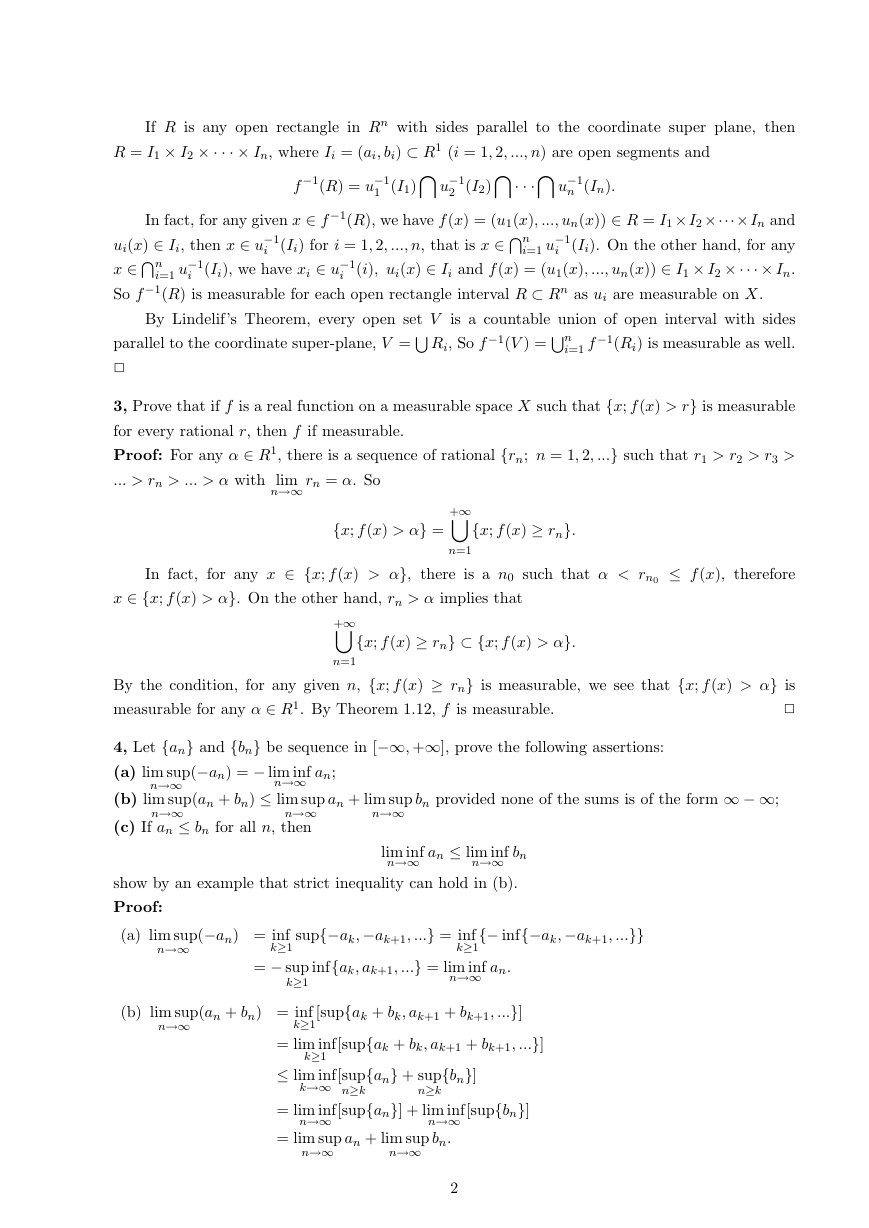
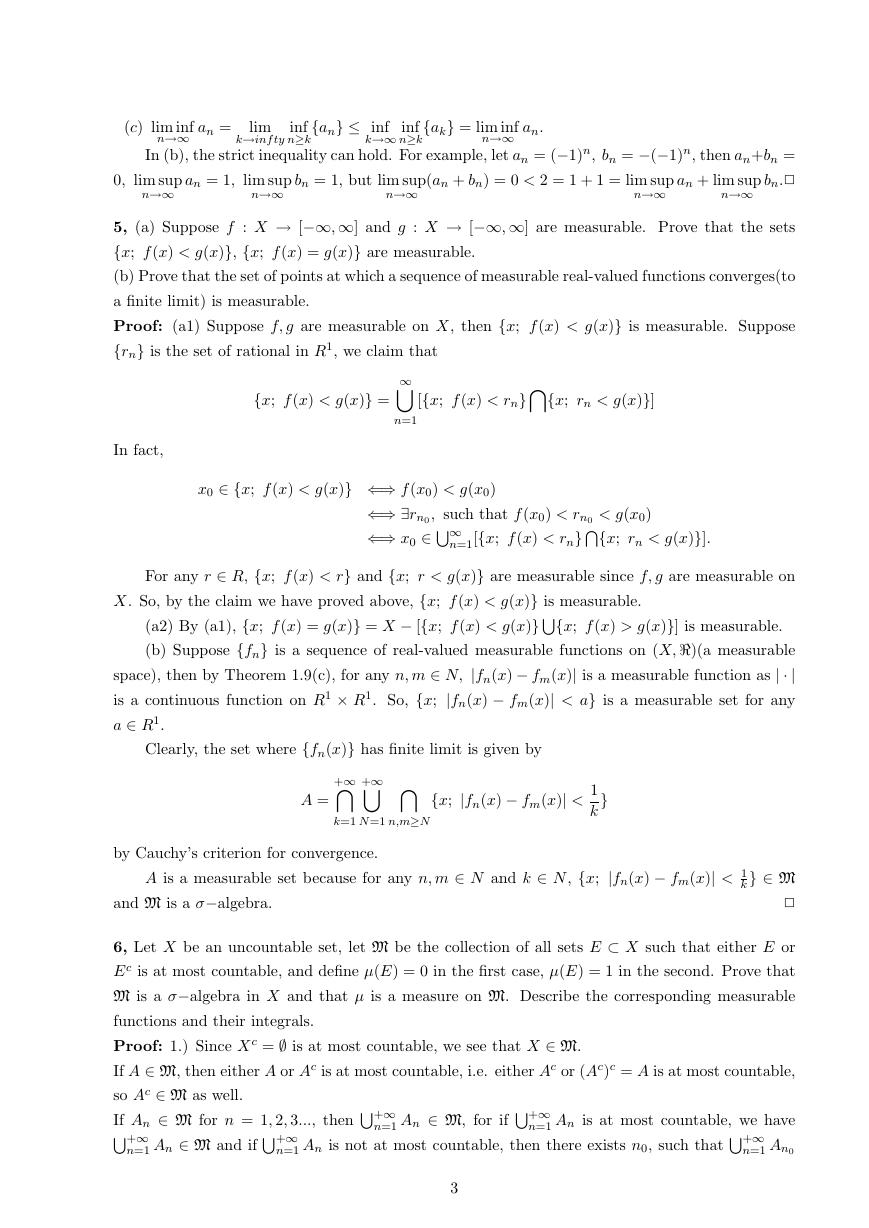
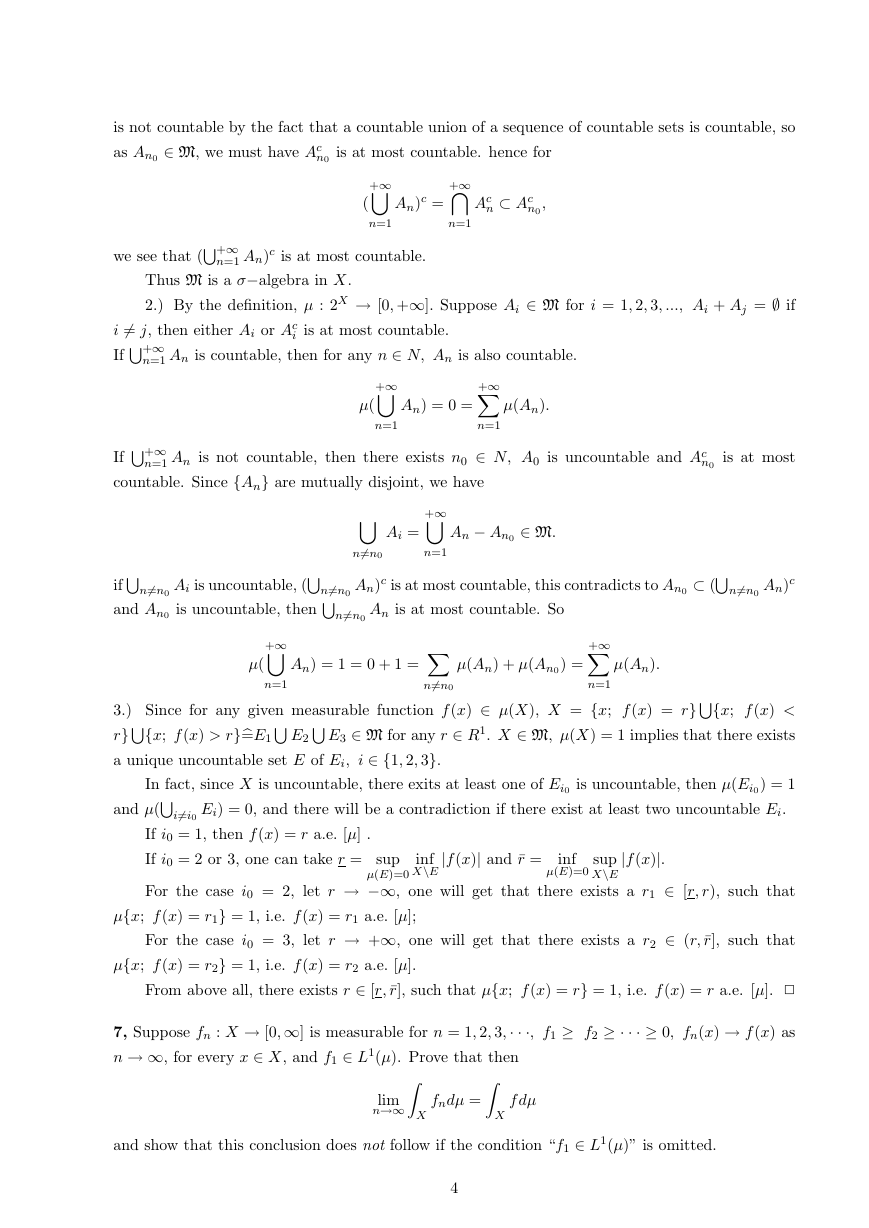
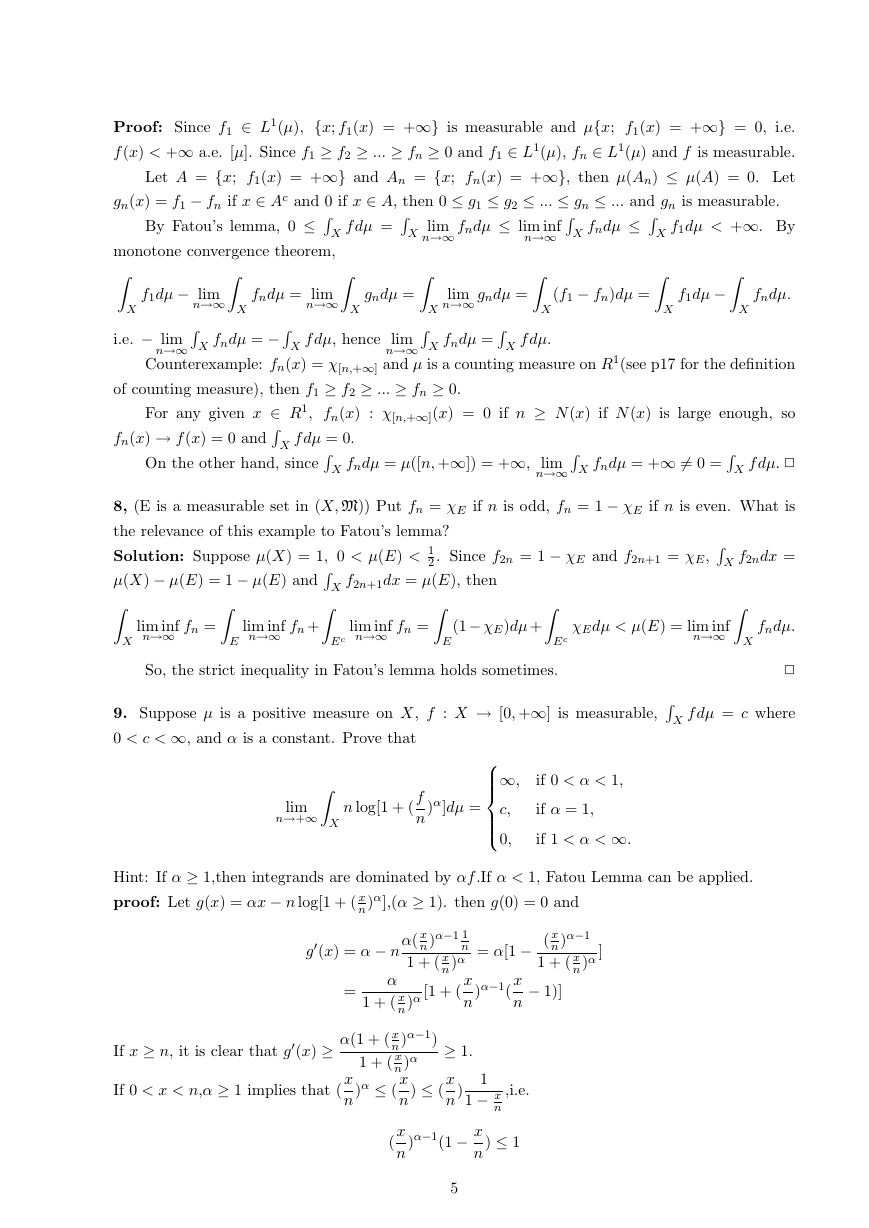
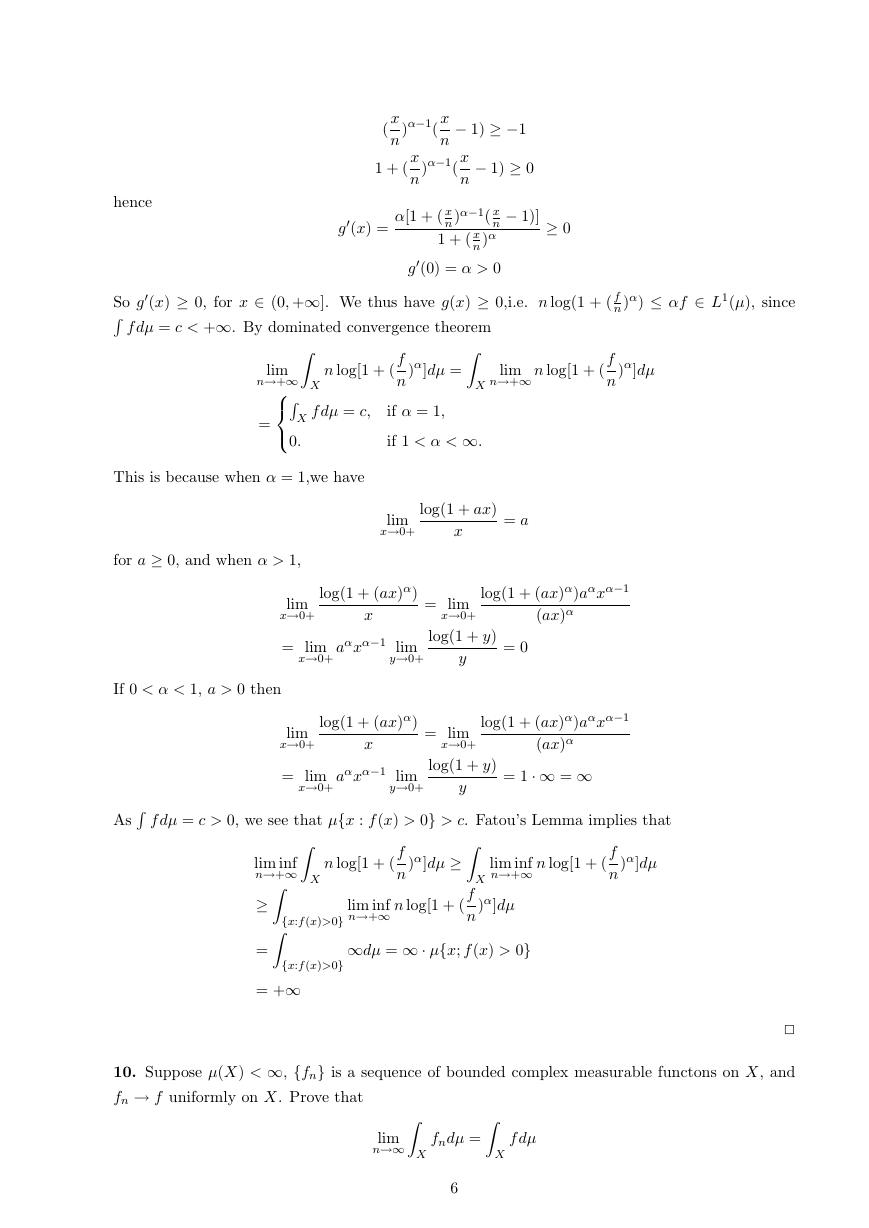
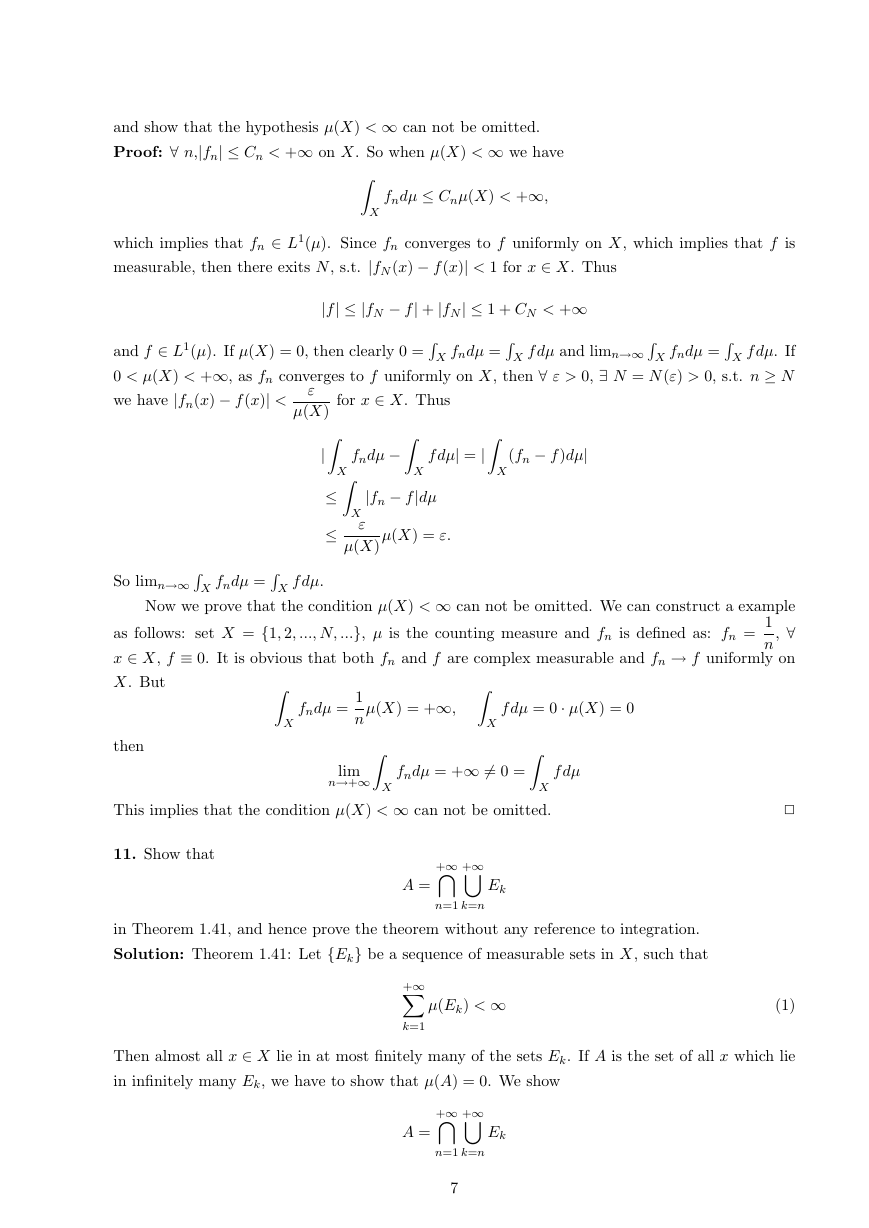
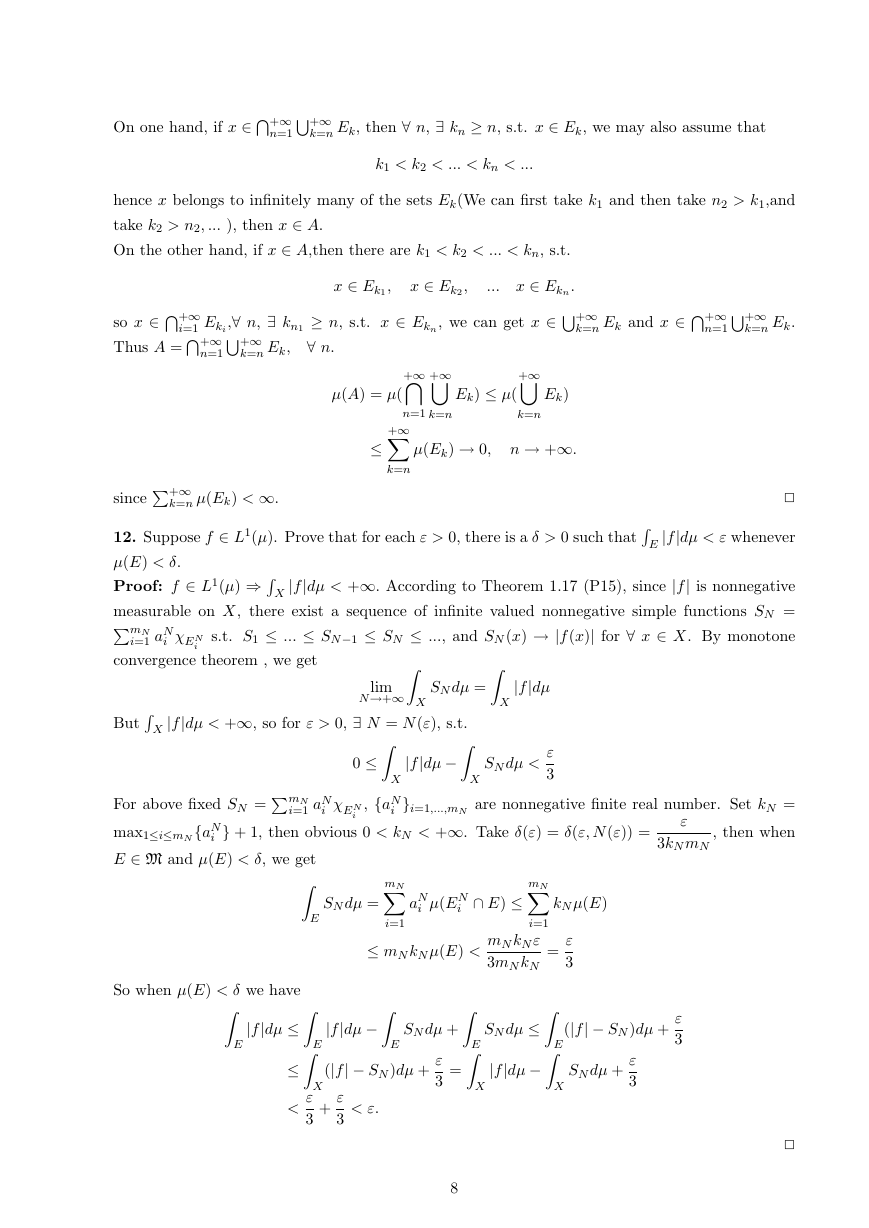








 2023年江西萍乡中考道德与法治真题及答案.doc
2023年江西萍乡中考道德与法治真题及答案.doc 2012年重庆南川中考生物真题及答案.doc
2012年重庆南川中考生物真题及答案.doc 2013年江西师范大学地理学综合及文艺理论基础考研真题.doc
2013年江西师范大学地理学综合及文艺理论基础考研真题.doc 2020年四川甘孜小升初语文真题及答案I卷.doc
2020年四川甘孜小升初语文真题及答案I卷.doc 2020年注册岩土工程师专业基础考试真题及答案.doc
2020年注册岩土工程师专业基础考试真题及答案.doc 2023-2024学年福建省厦门市九年级上学期数学月考试题及答案.doc
2023-2024学年福建省厦门市九年级上学期数学月考试题及答案.doc 2021-2022学年辽宁省沈阳市大东区九年级上学期语文期末试题及答案.doc
2021-2022学年辽宁省沈阳市大东区九年级上学期语文期末试题及答案.doc 2022-2023学年北京东城区初三第一学期物理期末试卷及答案.doc
2022-2023学年北京东城区初三第一学期物理期末试卷及答案.doc 2018上半年江西教师资格初中地理学科知识与教学能力真题及答案.doc
2018上半年江西教师资格初中地理学科知识与教学能力真题及答案.doc 2012年河北国家公务员申论考试真题及答案-省级.doc
2012年河北国家公务员申论考试真题及答案-省级.doc 2020-2021学年江苏省扬州市江都区邵樊片九年级上学期数学第一次质量检测试题及答案.doc
2020-2021学年江苏省扬州市江都区邵樊片九年级上学期数学第一次质量检测试题及答案.doc 2022下半年黑龙江教师资格证中学综合素质真题及答案.doc
2022下半年黑龙江教师资格证中学综合素质真题及答案.doc